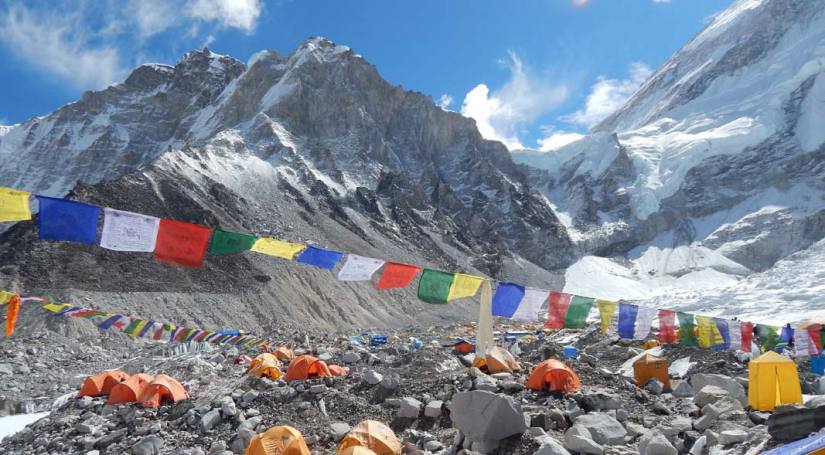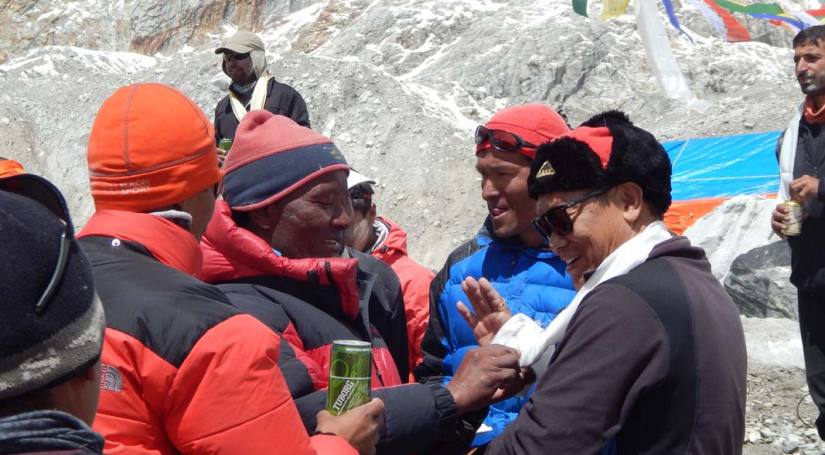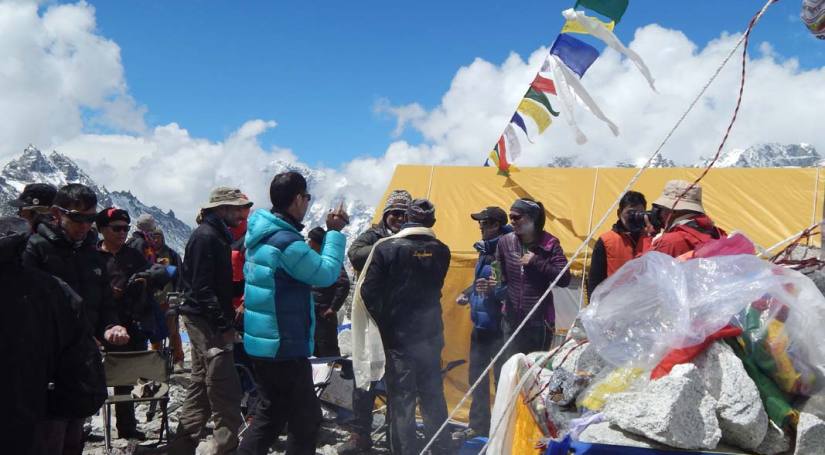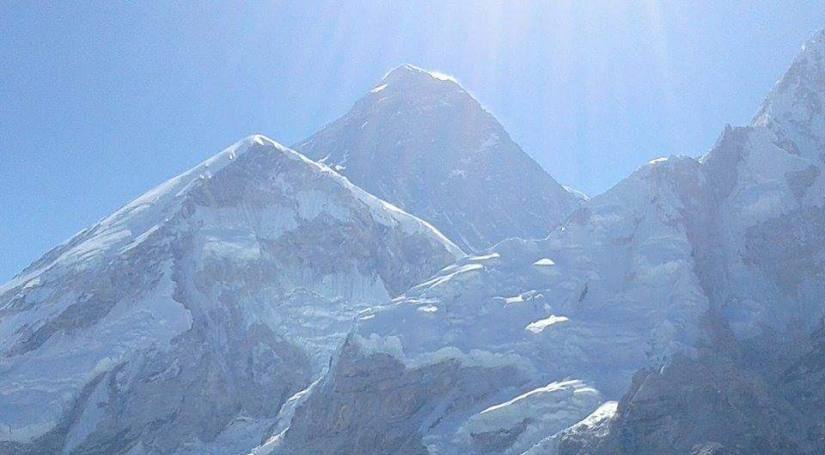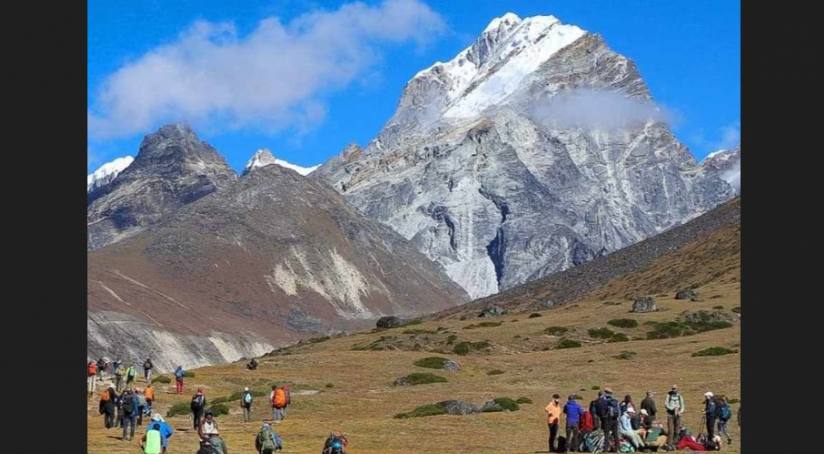Mt. Everest Expedition-8848.86m (60 Days) Nepal South Side, Full-Board Services - 2026 April-05th - 60 Days
-
Trip Code HTA-19
-
Duration: 60 Days
-
Trip Grade Moderate
Trip Highlights
- Attempt to summit the highest peak, Mount Everest
- Spectacular view of all the Himalayas in Nepal
- Experiencing the traditional culture of Sherpa people and their hospitality
- Buddhists monasteries in the foothills of the mighty Himalayas
- Grandest walk in the Land of Himalayas
- A short visit to the world heritage sites in Kathmandu as well
About Trip:
Mt. Everest climbing has proved to be a benchmark of climbing achievement. The mountain receives around 600-700 summit attempts every year. Everest can be climbed both from the southern side of Nepal and the northern side of Tibet. After the Cultural Revolution in the 1950s, China closed the Tibet borders to outsiders and Nepal began welcoming foreigners to the Everest Region. Since then, the southern approach to the mountain via the Khumbu Valley has become popular among climbers. Mt. Everest was first summited in 1953 by Tenzing Norgay Sherpa and Edmund Hillary via the South Col. Climbing Mt. Everest is certainly a lifetime opportunity. However, these days Everest expeditions is conducted from both the north and south side and have encountered many seen, and unseen obstacles including high altitude, harsh weather conditions, and even sheer exhaustion. Therefore, we strive hard to conduct the best expedition program putting high importance on the safety aspects of the climb. As we all know it is getting heavily commercialized these days but we prioritize safety by focusing on the proper acclimatization process by doing an additional above 6000m peak(lobuche east) right before the expedition to prevent many rotations in the dangerous Khumbu icefall & by providing top senior most experienced sherpas if you can help us in the early confirmation process.
Outline Itinerary
Day 01: Arrival in Kathmandu & transfer to hotel-1300m/4264ft
Day 02-03: At leisure in Kathmandu
Day 04: Fly to Lukla & Trek to Phakding - 2,840m/9,315ft
Day 05: Trek to Namche Bazar
Day 06: At leisure in Namche Bazar
Day 07: Trek to Tyangboche or Dibuche
Day 08: Trek to Dingboche
Day 09: Acclimatization
Day 10: Trek to Lobuje
Day 11: Trek to Lobuje Basecamp (4,940m/16,210 ft.)
Day 12: Rest Day at Lobuje base camp
Day 13: Ascent to Lobuje high Camp (5,400m/17,712ft)
Day 14: Lobuje Summit (6,119m/20,070 ft) and back to base camp
Day 15: Trek to Gorakshep (5,170 m/16,961ft)
Day 16: Trek to Everest Base Camp
Day 17-19: Rest and preparation
Day 20-53: Ascent of Mt Everest
Day 54: Withdraw to Base Camp
Day 55: Return to Tyangboche or Dibuche
Day 56: Return trek to Namche Bazaar via Dinboche and Thyangboche
Day 57: Trek to Lukla
Day 58: Fly Lukla to Kathmandu
Day 59: Free Day in Kathmandu
Day 60: Fly Back Home
Cost Includes:
- Expedition permit fees for Everest & lobuche east.
- 5 nights’ accommodations in Kathmandu with bed and breakfast facility.
- Flights from Kathmandu to Lukla and back including airport transfers.
- All overnight accommodations while on the trek and climb.
- Climbing equipment for group like ropes, snow bar, ice screw, etc. which are necessary.
- 5 oxygen bottles (each of 4 liters) per member and 4 oxygen bottles per sherpa; 1 bottle of oxygen lasts for 5/6 hours.
- Set up regulator mask of high quality for member and Sherpas.
- Liaison officer by government with his equipment, wages, insurance, and all his facilities.
- Equipment transportation by yaks or porter and means of transportations (like helicopter etc.)
- Communication services i.e., walkie-talkie.
- Services of kitchen, dining with tents which are required in the base camp, toilet tents, heater, (per member:1 tent till base camp and sharing above base camp) (cook service till base camp and camp 2)
- Insurance, equipment, rescue facility and daily wages of Sherpas and Nepalese kitchen staffs with good experienced cook with necessary Nepalese kitchen staffs.
- Helpful and Experienced Climbing Sherpas for member (at-least summited multiple times Everest before. including other mountains as well.)
- Rope Fixing Entire Team To the Summit(With Equipments required and carry bonus from base camp to summit.)
- Solar power
- Welcome Dinner
- Rope fixing team for expedition
- High foods above base camp and high cooking pots, EP gas, and other necessaries.
Cost Excludes:
- International airfares to and from Nepal.
- Lunch and Dinner while in Kathmandu
- Nepal Visa fees
- Member's Travel and rescue insurance
- Extra expenses by member like Laundry fees, drinks, phone calls, shower, etc.
- All foods and beverages other than on the itinerary.
- Personal gears and equipment.
- Good Tips for guides, porters and drivers
- 1500 US$ per Sherpa as summit bonus
- Services more than included in “Trip Includes” section.
- Insurance and Trip cancellation
- No credit facility(Banks charges are applied to member)
Trip Map
Day 01: Arrival in Kathmandu & transfer to hotel-1300m/4264ft
Upon your arrival in the Kathmandu airport, you will be greeted by a representative of Himalayan Traverse. You will be then transferred to your hotel. After check in, you will meet your guide as well as other participants and do final preparation for the trip.
Day 02-03: At leisure in Kathmandu
Sightseeing and Everest Expedition Preparation
While the expedition leader attends a formal briefing at the Ministry of Tourism, you will have the chance to explore the vibrant city of Kathmandu. The day includes a guided tour of some of the valley’s UNESCO World Heritage Sites, including Kathmandu Durbar Square, Pashupatinath Temple, Swayambhu (Monkey Temple), and Boudhanath Stupa.
This day is also dedicated to completing all official formalities and expedition arrangements. You will receive a briefing on the expedition, team composition, and required equipment. It’s the perfect opportunity for last-minute purchases of personal items before heading to the Himalayas.
In the late afternoon, the leader will check everyone’s gear to ensure nothing essential is missing. You will also meet your fellow expedition members and guides. The day concludes with a welcome dinner, offering a taste of authentic Nepalese cuisine.
Day 04: Fly to Lukla & Trek to Phakding - 2,840m/9,315ft
An early morning scenic flight to Lukla. The mountain flight over to Lukla is one of the most beautiful air routes in the world culminating in a dramatic landing on a hillside surrounded by high mountains peaks. In Lukla, we will meet our camp staff and porters. After meeting our other crew members and with some packing and arrangements, we start our trek through the prosperous village of Lukla until we reach Phakding. Phakding lies on the main trade route through the area and there are a number of clean well-built lodges where we can spend the night.
Day 05: Trek to Namche Bazar
Continue up the banks of the Dudh Kosi, crossing it twice by small suspension bridges before reaching the village of Monjo where we will enter the Khumbu National Park. Cross the confluence of the Dudh Kosi and the Bhote Kosi on a high suspension bridge and climb steeply for about two hours to reach Namche Bazaar. This is a prosperous trading town and the capital of the Khumbu region with genuine Tibetan artifacts.
Day 06: At leisure in Namche Bazar
We spend the day in Namche Bazaar resting and allowing our bodies to adjust to the altitude of 3,450m (11,300 ft). Even though it is a leisure day, it is important to remain active. Health experts recommend light activity rather than complete rest to aid proper acclimatization.
During the day, we may take a short hike to Thame, visit Khunde, or explore Namche Bazaar itself. This bustling town is the main hub of the Everest (Khumbu) region, with government offices, ATMs, internet cafes, shops, restaurants, a bakery, and a lively market on Friday evenings and Saturdays. Trekking a few hundred vertical feet during the day helps our bodies adjust to the altitude more effectively.
Our guides will also take us to the Tourist Visitor Center near the Sagarmatha National Park headquarters, where we can learn about the first Everest climbers, Sherpa culture, and the plants and wildlife of the Everest region.
Day 07: Trek to Tyangboche or Dibuche
The classic Everest trail winds along the valley, high above the Dudh Kosi River. Along the way, we are treated to our first breathtaking views of the Khumbu’s towering peaks, including Everest, Lhotse, Nuptse, and Ama Dablam. The trail passes through several small villages and numerous tea houses. After crossing the Dudh Kosi, we make a steep ascent to Thyangboche, famous for its impressive, recently rebuilt monastery.
Day 08: Trek to Dingboche
We walk past several Chortens, Mani walls, and small villages along the way. Lunch is enjoyed with stunning close-up views of Ama Dablam. The trail, shaded by rhododendron trees, gradually descends toward the river and crosses another airy suspension bridge. About an hour’s walk from here brings us to Pangboche, a fantastic viewpoint for Ama Dablam. Following the contour along the valley side, we cross the river again and continue up the Imja Valley to arrive at the charming farming village of Dingboche.
Day 09: Acclimatization
This stage of the expedition is crucial. Dingboche offers an ideal setting for acclimatization. The team leader will plan daily hikes to nearby hills to help the group adjust gradually to the altitude. Take walks on the surrounding slopes to slowly build your tolerance to higher elevations. Stick to the acclimatization routine that has worked best for you to ensure you are well-prepared before reaching base camp.
Day 10: Trek to Lobuje
Retrace your steps back to Pheriche before continuing along the trail toward base camp. Stop at Dugla, located just below the Khumbu Glacier’s snout, which is a convenient spot for lunch. After eating, the path ascends steeply alongside the glacier’s moraine. A few hours of trekking will bring you to a small group of tea houses nestled in Lobuche.
Day 11: Trek to Lobuje Basecamp (4,940m/16,210 ft.)
This day we move to lobuje base camp from lobuje for the ascent of the mountain.
Day 12: Rest Day at Lobuje base camp
An extra day is planned to account for unforeseen delays, such as flight disruptions or adverse weather conditions. This buffer ensures that even with a one-day setback, the expedition can continue smoothly, increasing the likelihood of a successful climb.
Pre-Climb Training: Our guides will conduct sessions on essential peak climbing techniques and the correct use of equipment, including ice axes, climbing boots with crampons, harnesses, and ascenders. Training will also cover rope handling for both ascending and descending. This preparation is designed to build your confidence, enhance your climbing skills, and maximize your chances of reaching the summit while fully enjoying the experience.
Day 13: Ascent to Lobuje high Camp (5,400m/17,712ft)
From Lobuche, the trek continues toward Lobuche Base Camp. The initial part of the trail is relatively flat, but it becomes steeper and rockier as you approach the base camp. Along the way, you will follow the Lobuche Glacier and enjoy spectacular views of Ama Dablam, Cholatse, Pokalde, Thamserku, Kantega, and other Himalayan peaks.
From the base camp, the path climbs over a rocky moraine to reach the High Camp. Once there, we set up camp, have lunch, and rest. During the climb, the terrain is usually rocky up to about 5,770 meters, after which we traverse icy sections and use ropes as needed. The type and length of ropes—fixed or man ropes—depend on the season and the presence of crevasses, with climbing leaders determining the safest approach. Overnight is spent at Lobuche East High Camp.
Day 14: Lobuje Summit (6,119m/20,070 ft) and back to base camp
Today, we wake up very early, around 12 to 1 am, and have breakfast before starting our climb. Reaching the summit before noon is crucial, as strong afternoon winds at high altitude can make climbing more difficult. The ascent begins on rocky terrain up to approximately 5,700 meters, after which we continue on ice. Both fixed ropes and man ropes are used according to the instructions of the climbing leader. The type of surface, rope length, and technique depend on the season and the presence of crevasses.
Lobuche East provides some of the most panoramic mountain views among trekking peaks. From the summit, you can enjoy breathtaking vistas of Everest, Lhotse, Nuptse, Ama Dablam, Cholatse, Pumori, and many other peaks. After celebrating and taking photos at the top, we descend back to High Camp and then continue down to Base Camp for an overnight stay.
(Note: The reason behind the lobuje ascent is to decrease the up and downs by the khumbu icefall as its abit risky there by doing the acclimatization in lobuje. If we don’t do the lobuje ascent then we from Everest base camp do the camp 1(18,300ft.) overnight then to reach camp 2(20,000ft) the other day, finally back the Everest base back which will be for the acclimatization. But incase lobuje is done then we do camp 1 overnight for a day, camp2 overnight 3/4 day... in which camp 3(21,300ft) touch is done then camp 2 overnight then camp 3 overnight. Finally, back base camp (This makes 1st course cleared) for the final summit target.)
Day 15: Trek to Gorakshep (5,170 m/16,961ft)
This day we move from base camp to Gorakshep and overnight there.
Overnight in Gorakshep.
Day 16: Trek to Everest Base Camp
Contouring along the valley-side and looking down on the Khumbu Glacier, follow a reasonable trail to Gorak Shep. This was the site of the base camp in 1953 and now consists of a few small tea houses. Leaving Gorak Shep, the trail leads on to the moraine of the Khumbu Glacier and becomes quite vague, weaving between mounds of rubble and eventually reaching base camp near the foot of the Khumbu Icefall. This will be our home for the next six weeks.
Day 17-19: Rest and preparation
Day 20-53: Ascent of Mt Everest
Day 54: Withdraw to Base Camp
All team members return to base camp and assist with packing expedition stores and cleaning the base camp area.
Day 55: Return to Tyangboche or Dibuche
Day 56: Return trek to Namche Bazaar via Dinboche and Thyangboche
Day 57: Trek to Lukla
Day 58: Fly Lukla to Kathmandu
We will return to the Hotel. We need to take rest of the day.
Day 59: Free Day in Kathmandu
Day 60: Fly Back Home
This is the biggest expeditions in Nepal and it is only organized for Spring. So the trip must be confirmed before 6 months for further bookings and paperwork which is a long process and we have to send the name list in Government system and also for experienced Sherpas which are very much necessary for the trip. All paperwork must be done before April. A four-liter bottle of oxygen generally works for 6 hours.
Thank you.
You May Also Like
- Mt. Dhaulagiri Expedition (8,167m/26,795ft)
- Kanchenjunga Expedition (8,586m./28,169ft.)
- Mt. Everest Expedition Nepal South Side & Lhotse- Full Board Services(April-5th)
- Annapurna I Expedition (8,091m./26,545ft.) -Full-Board.
- Mt. Manaslu Expedition August-29th(Full-board)
- Mt. Makalu Expedition
- Mt. Lhotse Expedition
Trip Info
Trek to Langtang
We first met Dorjee Sherpa in 2012 and did a trek with him to Langtang before it was devastated in the earthquake. We quickly fell in love with the himalayas, the Nepalese people, their culture, and Dorjee shepa. The Langtang trek was a beautiful trek and a great introductory to the…
 Matt massey, United StatesDecember 16, 2025
Matt massey, United StatesDecember 16, 2025
Trek to Tyangboche
Just got home from our second trek in the Himalayas with Dorjee sherpa. We treked to tengboche for the mani rimdu festival. The festival was incredible and the mountains are magnificent. Dorjee is a great guide and we really enjoyed staying at his Buddha lodge and meeting his wonderful family.
 Matt massey, United StatesDecember 16, 2025
Matt massey, United StatesDecember 16, 2025
Mani Rimdu Festival trek
My family and friends from Maui completed a 10 day trek through Sagarmatha National Park to Tengboche to view the Mani Rimdu Festival in November . Our Guide Dorjee Sherpa and his associates arranged a fantastic trip for us. We stayed at his Buddha Lodge in Phakding and were treated very…
 Kevin Horan, NepalDecember 16, 2025
Kevin Horan, NepalDecember 16, 2025
Have fun with trust!
I spent very memorable days in the Everest region in Nepal. I used to dream to see this highest peak of the world and now I arrested it in my camera. My guide arranged everything and helped me a lot. He did not let me feel tired and boring.
 Austin, Netherlands AntillesDecember 16, 2025
Austin, Netherlands AntillesDecember 16, 2025
Certificate & Partners





